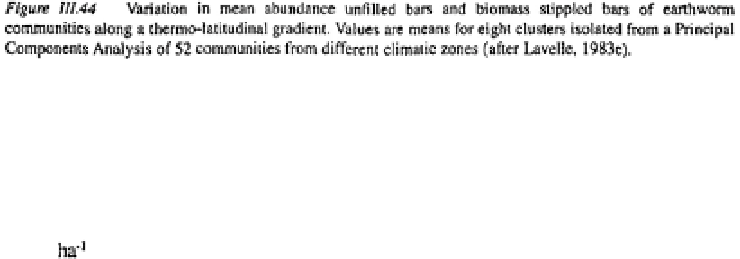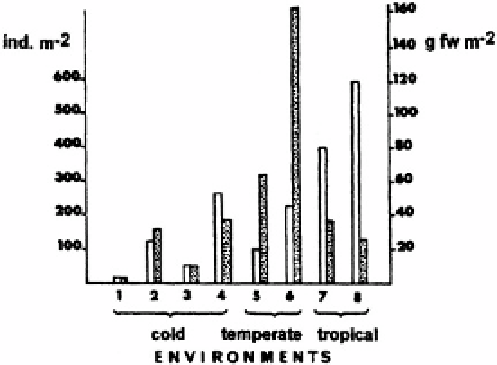Agriculture Reference
In-Depth Information
Markedly different patterns of abundance occur at decreasing spatial scales (see
reviews in Edwards and Bohlen, 1996; Lavelle, 1983c; Lee, 1985):
(i) at a worldwide geographical scale there is a clear thermo-latitudinal gradient, as mean
population density in natural environments tends to increase from a few tens on average
in cold temperate areas to maximum values of several hundred in the tropics. In contrast,
biomass increases from cold to mild temperate environments and then decreases again
towards tropical latitudes (Figure III.44);
(ii) at a regional (landscape) scale, soil and vegetation regimes greatly influence
earthworm abundance (Stöckli, 1928). Grasslands tend to have much larger populations
than forests. This is particularly in the case of temperate or tropical pastures colonised
either by exotic peregrine species, or by adapted local species. These may have biomasses
of 1 t or more whereas an adjacent forest may only have approximately half as much
(Lavelle and Pashanasi, 1989). Large biomasses may also be associated with a high soil
nutrient status as, for example, in tropical rainforest communities (Fragoso and Lavelle, 1992).
(iii) at a local scale, variation in soils, land-use and cultivation techniques greatly
influence earthworm populations. Cultivation and the application of nematicides and
fungicides generally depress earthworm abundances. In contrast, most herbicides have
no significantly deleterious effects and cattle grazing in pastures has positive effects
(Edwards and Lofty, 1982; Haines and Huren, 1990; House and Parmelee, 1985; Lavelle
and Pashanasi, 1989; Lee, 1985; McKay and Kladivko, 1985; Parmelee
et al.,
1990;
Yule
et al.,
1991).


